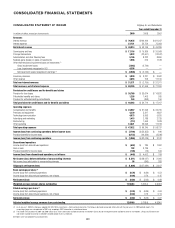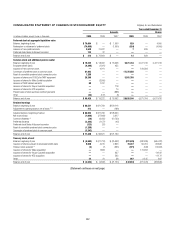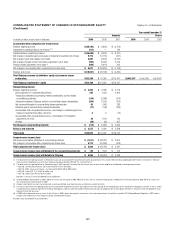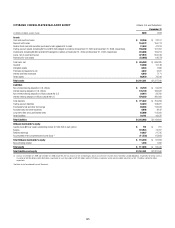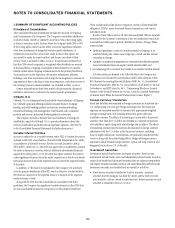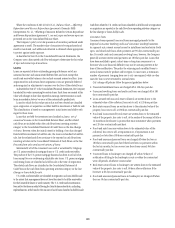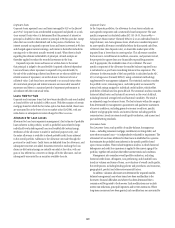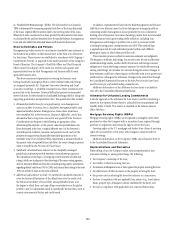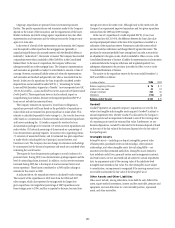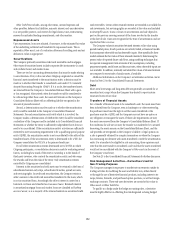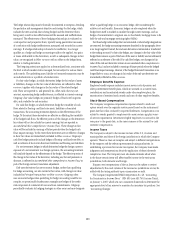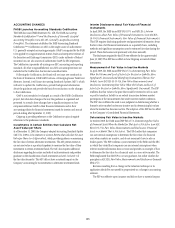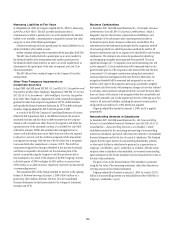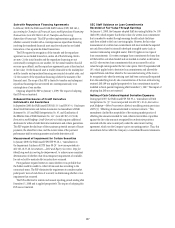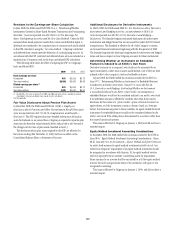Citibank 2009 Annual Report Download - page 139
Download and view the complete annual report
Please find page 139 of the 2009 Citibank annual report below. You can navigate through the pages in the report by either clicking on the pages listed below, or by using the keyword search tool below to find specific information within the annual report.129
Corporate loans
Corporate loans represent loans and leases managed by ICG or the Special
Asset Pool. Corporate loans are identified as impaired and placed on a cash
(non-accrual) basis when it is determined that the payment of interest or
principal is doubtful or when interest or principal is 90 days past due, except
when the loan is well collateralized and in the process of collection. Any
interest accrued on impaired corporate loans and leases is reversed at 90 days
and charged against current earnings, and interest is thereafter included in
earnings only to the extent actually received in cash. When there is doubt
regarding the ultimate collectability of principal, all cash receipts are
thereafter applied to reduce the recorded investment in the loan.
Impaired corporate loans and leases are written down to the extent
that principal is judged to be uncollectible. Impaired collateral-dependent
loans and leases, where repayment is expected to be provided solely by
the sale of the underlying collateral and there are no other available and
reliable sources of repayment, are written down to the lower of cost or
collateral value. Cash-basis loans are returned to an accrual status when
all contractual principal and interest amounts are reasonably assured of
repayment and there is a sustained period of repayment performance in
accordance with the contractual terms.
Loans Held-for-Sale
Corporate and consumer loans that have been identified for sale are classified
as loans held-for-sale included in Other assets. With the exception of certain
mortgage loans for which the fair value option has been elected, these loans
are accounted for at the lower of cost or market value (LOCOM), with any
write-downs or subsequent recoveries charged to Other revenue.
Allowance for Loan Losses
Allowance for loan losses represents management’s best estimate of probable
losses inherent in the portfolio, as well as probable losses related to large
individually evaluated impaired loans and troubled debt restructurings.
Attribution of the allowance is made for analytical purposes only, and
the entire allowance is available to absorb probable credit losses inherent
in the overall portfolio. Additions to the allowance are made through the
provision for credit losses. Credit losses are deducted from the allowance, and
subsequent recoveries are added. Securities received in exchange for loan
claims in debt restructurings are initially recorded at fair value, with any
gain or loss reflected as a recovery or charge-off to the allowance, and are
subsequently accounted for as securities available-for-sale.
Corporate loans
In the Corporate portfolios, the allowance for loan losses includes an
asset-specific component and a statistically-based component. The asset
specific component is calculated under ASC 310-10-35, Receivables—
Subsequent Measurement (formerly SFAS 114) on an individual basis for
larger-balance, non-homogeneous loans, which are considered impaired.
An asset-specific allowance is established when the discounted cash flows,
collateral value (less disposal costs), or observable market price of the
impaired loan is lower than its carrying value. This allowance considers
the borrower’s overall financial condition, resources, and payment record,
the prospects for support from any financially responsible guarantors
and, if appropriate, the realizable value of any collateral. The asset
specific component of the allowance for smaller balance impaired loans
is calculated on a pool basis considering historical loss experience. The
allowance for the remainder of the loan portfolio is calculated under ASC
450, Contingencies (formerly SFAS 5) using a statistical methodology,
supplemented by management judgment. The statistical analysis considers
the portfolio’s size, remaining tenor, and credit quality as measured by
internal risk ratings assigned to individual credit facilities, which reflect
probability of default and loss given default. The statistical analysis considers
historical default rates and historical loss severity in the event of default,
including historical average levels and historical variability. The result is
an estimated range for inherent losses. The best estimate within the range is
then determined by management’s quantitative and qualitative assessment
of current conditions, including general economic conditions, specific
industry and geographic trends, and internal factors including portfolio
concentrations, trends in internal credit quality indicators, and current and
past underwriting standards.
Consumer loans
For Consumer loans, each portfolio of smaller-balance, homogeneous
loans—including consumer mortgage, installment, revolving credit, and
most other consumer loans—is independently evaluated for impairment. The
allowance for loan losses attributed to these loans is established via a process
that estimates the probable losses inherent in the specific portfolio based
upon various analyses. These include migration analysis, in which historical
delinquency and credit loss experience is applied to the current aging of the
portfolio, together with analyses that reflect current trends and conditions.
Management also considers overall portfolio indicators, including
historical credit losses, delinquent, non-performing, and classified loans,
trends in volumes and terms of loans, an evaluation of overall credit quality,
the credit process, including lending policies and procedures, and economic,
geographical, product and other environmental factors.
In addition, valuation allowances are determined for impaired smaller-
balance homogeneous loans whose terms have been modified due to the
borrowers’ financial difficulties and where it has been determined that a
concession will be granted to the borrower. Such modifications may include
interest rate reductions, principal forgiveness and/or term extensions. Where
long-term concessions have been granted, such modifications are accounted for



